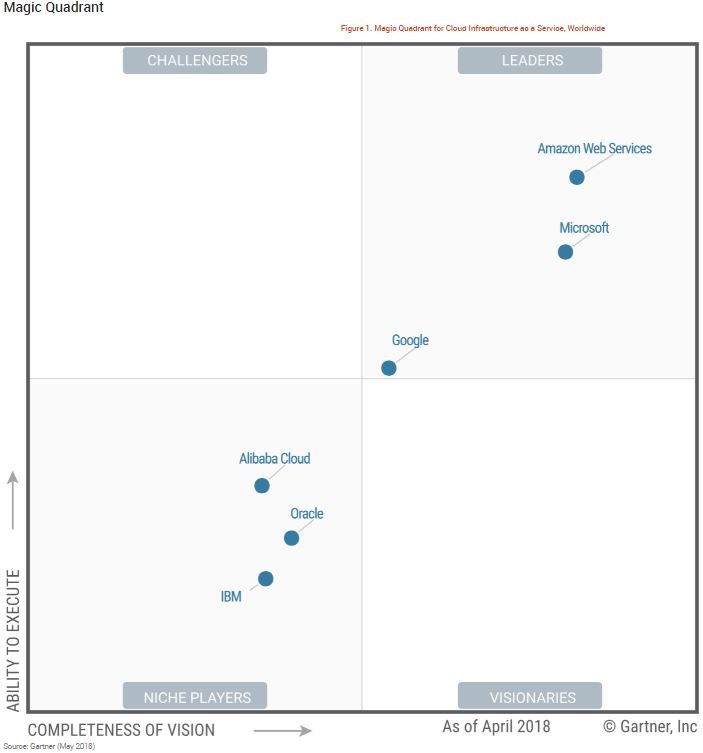Gartner Magic Quadrant
Amazon Web Services was placed in the “Leaders” quadrant and positioned the furthest on completeness of vision and the highest ability to execute axes. – Gartner Magic Quadrant
Amazon Web Services
Amazon Web Services (AWS), a subsidiary of Amazon, is a cloud-focused service provider. It pioneered the cloud IaaS market in 2006.
Offerings: AWS is integrated IaaS+PaaS. Its Elastic Compute Cloud (EC2) offers metered-by-the-second multitenant and single-tenant VMs, as well as bare-metal servers. AWS’s hypervisors are based on Xen and KVM. There is multitenant block and file storage, along with extensive additional IaaS and PaaS capabilities. These include object storage with an integrated CDN (Amazon Simple Storage Service [S3] and CloudFront), Docker container services (Amazon Elastic Container Service [ECS], ECS for Kubernetes [EKS], and Fargate container instances), a batch computing service (AWSBatch), event-driven “serverless computing” (Lambda) and an aPaaS-like developer experience (Elastic Beanstalk). It is willing to negotiate large-scale single-tenant and on-premises deals (such as the U.S. intelligence community cloud deal). The AWS Marketplace has an extensive selection of third-party software and services. VMware offers a VMware Cloud Foundation service within AWS data centers (VMware Cloud on AWS). Enterprise-grade support is extra. It has a multi-fault-domain SLA. Colocation needs are met via partner exchanges (AWS Direct Connect).
Locations: AWS groups its data centers into regions, each of which contains at least two availability zones (data centers). It has multiple regions across the U.S., as well as in Canada, France, Germany, Ireland, U.K., Australia, India, Japan, Singapore, South Korea and Brazil. It also has one region dedicated to the U.S. federal government. There are two China regions — Beijing (operated by Sinnet) and Ningxia (operated by Ningxia Western Cloud Data Technology [NWCD]) — which require a China-specific AWS account. It has a global sales presence. The portal and documentation are provided in English, Dutch, French, German, Italian, Japanese, Korean, Mandarin, Portuguese and Spanish. The primary languages for support are English, Japanese and Mandarin, but AWS will contractually commit to providing support in a large number of other languages.
Provider maturity: Tier 1. AWS has been the market pioneer and leader in cloud IaaS for over 10 years.
Recommended mode: AWS strongly appeals to Mode 2 buyers, but is also frequently chosen for Mode 1 needs. AWS is the provider most commonly chosen for strategic, organizationwide adoption. Transformation efforts are best undertaken in conjunction with an SI.
Recommended uses: All use cases that run well in a virtualized environment.
STRENGHTS
AWS has been the dominant market leader and an IT thought leader for more than 10 years, not only in IaaS, but also in integrated IaaS+PaaS, with an end-of-2017 revenue run rate of more than $20 billion. It continues to aggressively expand into new IT markets via new services as well as acquisitions, adding to an already rich portfolio of services. It also continues to enhance existing services with new capabilities, with a particular emphasis on management and integration.
AWS is the provider most commonly chosen for strategic adoption; many enterprise customers now spend over $5 million annually, and some spend over $100 million. While not the ideal fit for every need, it has become the “safe choice” in this market, appealing to customers that desire the broadest range of capabilities and long-term market leadership.
AWS is the most mature, enterprise-ready provider, with the strongest track record of customer success and the most useful partner ecosystem. Thus, it is the provider not only chosen by customers that value innovation and are implementing digital business projects, but also preferred by customers that are migrating traditional data centers to cloud IaaS. It can readily support mission-critical production applications, as well as the implementation of highly secure and compliant solutions. Implementation, migration and management are significantly eased by AWS’s ecosystem of more than 2,000 consulting partners that offer managed and professional services. AWS has the broadest cloud IaaS provider ecosystem of ISVs, which ensures that customers are able to obtain support and licenses for most commercial software, as well as obtain software and SaaS solutions that are preintegrated with AWS.
CAUTIONS
AWS’s extensive portfolio of services requires expertise to implement. Customers should be aware that while it’s easy to get started, optimal use — especially keeping up with new service innovations and best practices, and managing costs — may challenge even highly agile, expert IT organizations, including AWS partners. As new, less-experienced MSPs are added to AWS’s Audited MSP Partner program, this designation is becoming less of an assurance of MSP quality. However, since it sets a high minimum bar for MSP capabilities, it is still the best way to identify partners that use AWS best practices, especially when used in conjunction with the DevOps and Migration Partner competency designations.
Throughout its history, AWS has near-invisibly updated its service implementations as its scale and customer requirements have changed. Customers may need to make the active choice to gain the full advantage of some modernizations that represent a generational shift in technology, such as the new Nitro offloaded-virtualization platform that is used for some new EC2 instance types. Competitors that copy AWS ideas sometimes have the opportunity to improve on the implementation or service construct.
AWS is still adapting to the emergence of meaningful competitors — not only cloud providers, but also entrenched competitors in the new markets that it is entering with services that displace existing solutions. Also, as AWS introduces more open-source-compatible services, it has increasingly needed to work with open-source communities in a mutually beneficial fashion, and has begun to change its approach accordingly. Customers’ future technology choices are likely to be influenced by AWS’s ecosystem relationships.
Source: Gartner Magic Quadrant
